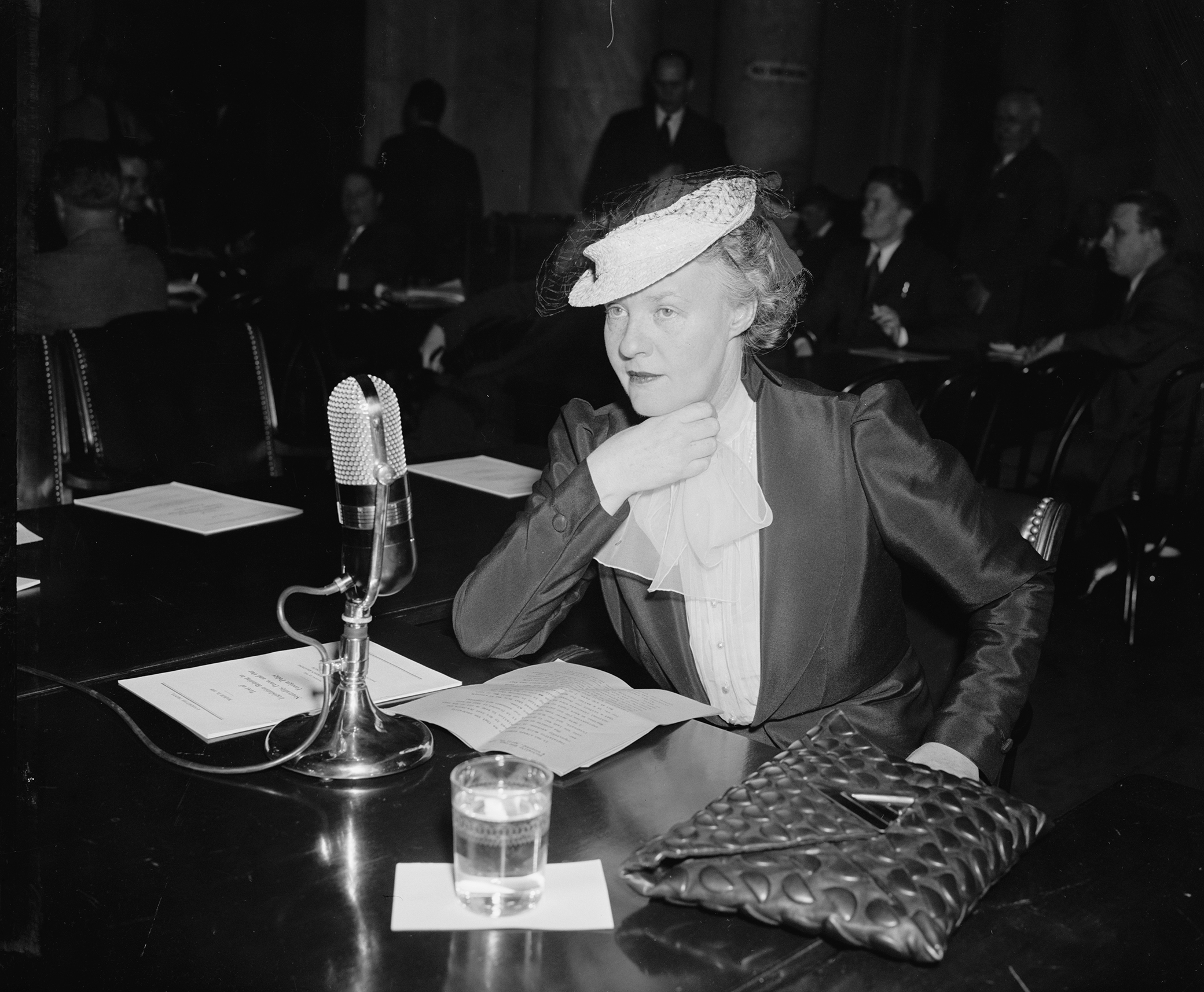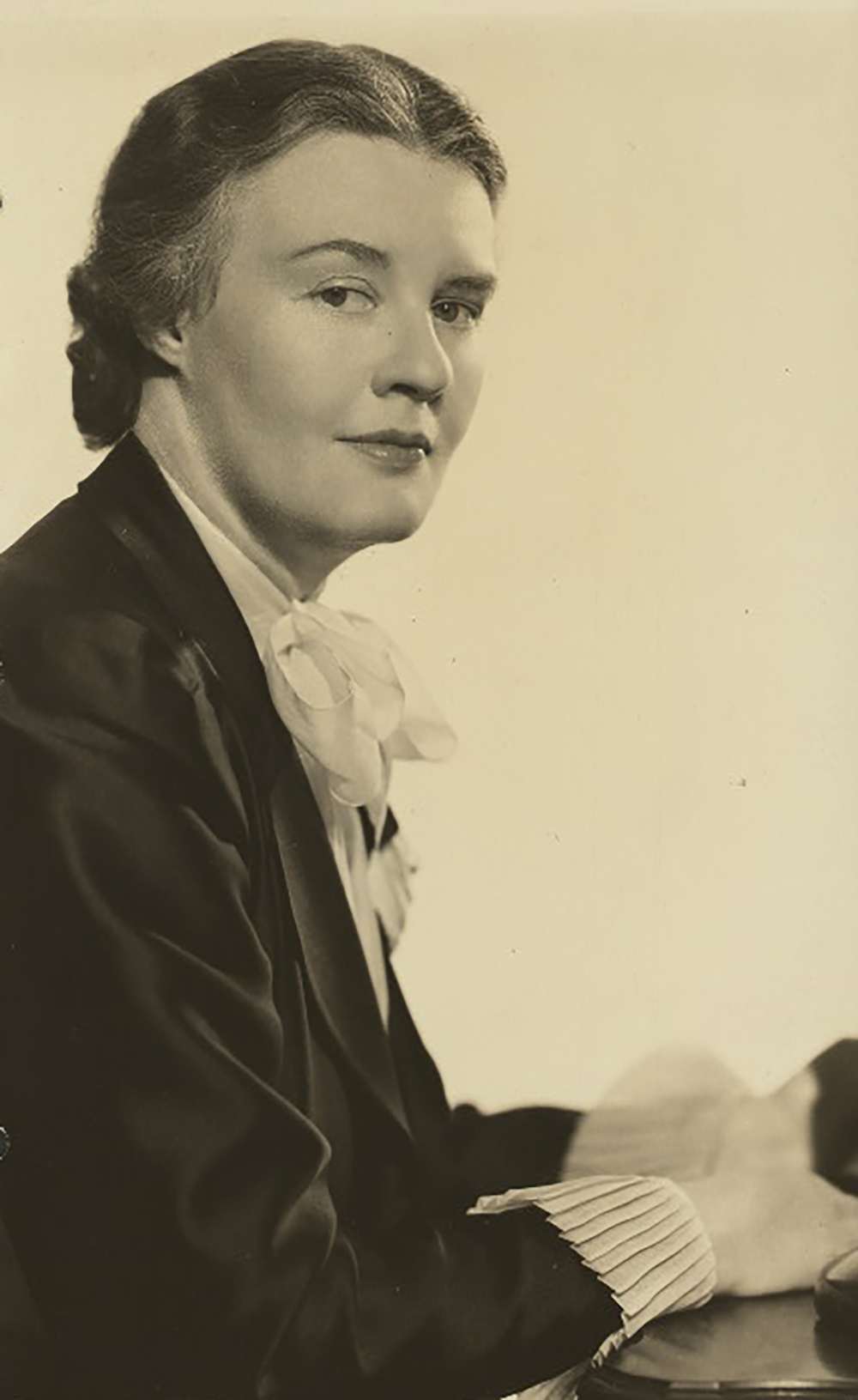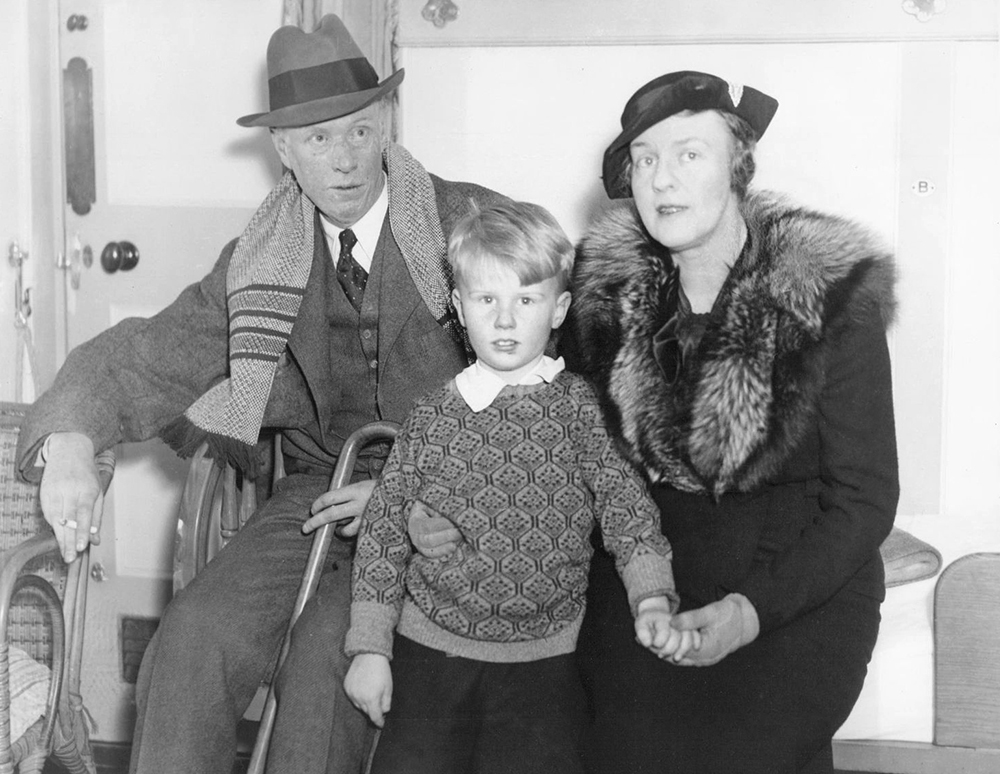
Dorothy Thompson testifies before the Senate Foreign Affairs Committee, 1939. Photograph by Harris & Ewing. Library of Congress, Prints and Photographs Division.
Political columnists became a new phenomenon in the 1930s, but not one of them was a woman until Helen Rogers Reid, wife of Ogden Reid, the owner and publisher of the New York Herald Tribune, approached journalist Dorothy Thompson about writing a column in their newspaper. Having already put an extraordinary number of women into responsible positions, Reid now offered Thompson a marvelous opportunity, and Thompson gladly grabbed it. She asked for a firm guarantee of freedom to speak her mind, and Helen and Ogden Reid more or less promised what she wanted.
Thompson named her column On the Record. It began on March 17, 1936, appearing on an ordinary newspaper page rather than on an opinion page. Producing a thousand to fifteen hundred snappy and meaningful words every Tuesday, Thursday, and Saturday would be no easy ride, Thompson understood. Helen Reid had imagined a “woman’s voice”; Thompson wrote about whatever was on her mind. She took on national and foreign politics, breaking news, court decisions, cultural innovations, social habits, historical change, intellectual trends. Six weeks into the job, she loved it, she told her friend Alexander Woollcott, a well-known New York drama critic, radio voice, and master of the bon mot. “I hope you are right about it getting to be easier,” she replied to Woollcott’s praise. “I’m like the gal who is put to teaching French to the high school kids. She means well, but she doesn’t know French and keeps just one jump ahead of the class.” To fellow journalist John Gunther she confided, “You have no idea how hard it is to write about American politics. This country is in a mess politically. I don’t know half time whether I’m on my head or my feet.” But she added delightedly, “I have the world’s best job.”
She made the column provocative, critical of many of FDR’s policies at home and vividly antifascist on the European situation. Pathos, condemnation, fierce analogy—all of these contributed to making her political feelings clear. Seventy daily newspapers signed on for syndication rights immediately. Soon that number doubled. Within two years, her column reached between seven and eight million newspaper subscribers. Of seven leading columnists profiled in The Nation in 1938, only Walter Lippmann’s potential audience of eight million exceeded Thompson’s, and not by much.
Packing lots of information into short space, and writing in down-to-earth language, Thompson moved easily from fire-breathing indignation to folksiness from one day to the next. For humor she invented the Grouse—a petulant and satirical character (often assumed by readers to represent her husband, Sinclair Lewis) with whom she held spirited dialogues. She did her writing in the mornings at home, at Twin Farms in Vermont in the warm months and in New York during the winters.
A generous hostess at both homes, she had a habit of directing social conversation to spark ideas for her columns. As a result she became known—not always kindly—for pumping knowledgeable people for tips. She trusted a coterie of well-informed male friends to give her insights and corrections on foreign affairs and employed three women as secretaries and research assistants.
Fascism continually pressed on Thompson’s mind not only as a monstrous reality in Europe but also as an American possibility. “It Can Happen Here” she titled her column on May 28, 1936, playing on the title of her husband’s novel to decry a thuggish vigilante group of white Protestant men who had murdered a relief worker in Detroit. Wherever she saw anti-Semitism she came down on it. She insisted that persecution of Jews ought to concern every American because it was antithetical to principles of democracy. In July she devoted two successive columns to “the lunatic fringe,” after the Reverend Gerald L.K. Smith, an effective speaker who attracted Huey Long’s supporters, defiantly adopted that phrase in self-description. Her outrage targeted several groups of extremist nationalists in whose rhetoric she saw the early Nazi movement mirrored. They included followers of the anti-Semitic “radio priest” Father Coughlin and of William Lemke, presidential candidate of the minuscule Union Party, who excoriated liberals, socialists, communists, immigrants, and people of color.
“No people ever recognize their dictator in advance,” Thompson warned. “When our dictator turns up, you can depend on it that he will be one of the boys…and he will stand for everything traditionally American.” In her echo of Lewis’ novel, she was alluding to what she saw as President Roosevelt’s overreach. She admired the president’s talents, but his 1937 “court-packing” proposal incensed her. FDR became so frustrated by the Supreme Court striking down New Deal policies that he proposed increasing the number of justices—whom he would have the power to appoint. FDR’s proposal never became a reality, but his attempt underlined Thompson’s grim belief that the state “is by its nature a predatory instrument.”

After the president called the Supreme Court a headache, Thompson opened her column with the Grouse “crankily” opining, “There is one certain cure for a headache…It is cheap, instantaneous and guaranteed. That remedy is decapitation.” The ridiculousness of such a “cure” led to Thompson playing the Grouse’s interlocutor and explaining the unconstitutionality of FDR’s scheme. An observation by the Grouse—“I see…that we are going to keep out of war”—likewise animated her critique of the Neutrality Act of 1937. Certain that Nazi Germany was preparing for war, she repeatedly hammered the point that neutrality legislation was mistaken in theory and practice, a brake on the exercise of American foreign policy.
As if her column were not enough, the radio networks also wanted Thompson. Three national networks (NBC, CBS, and the Mutual Broadcasting Service, MBS) operated in 1936, and Americans owned 33 million radios—eleven times as many as a dozen years before. Surveys indicated an average of three listeners for every radio, which suggested that 80 percent of the population could tune in at once. Thompson accepted a weekly spot on NBC, hosting a short late-evening program on personalities in the news. Her horror at fascist use of radio as a tool in Europe made her appreciate the airwaves’ impact; cold newsprint could not match the immediacy of a radio voice. She found it thrilling to address potential millions at once, especially in contrast to exhausting lecture tours. Broadcast, her voice was at once feminine, forceful, authoritative, and elegant, her pronunciation precise, with an accent hinting at upper-class Britain more than upstate New York. She could be heard on radio programs beyond her own, too, when called upon to address particular issues or events.
Millions of Americans already listened to Thompson on the radio and read her pithy column three days a week when the Ladies’ Home Journal came knocking, asking her to write a column that would spark women’s interest in politics. The Journal’s circulation outran that of every other women’s magazine and even that of the Saturday Evening Post. Thompson happily agreed to write a column every month for $1,000 each, equivalent to more than $17,000 today. She received six honorary university degrees in 1937; invitations to speak at forums, clubs, dinners, and commencements poured in by the hundreds. Americans debated her views over breakfast tables and at dinner parties, in office breaks and on the street. Whether revering or deploring her, they recognized her as the “First Lady of American Journalism.”
Sinclair Lewis could not endure it. When the German situation dominated conversation at home, as it often did during social occasions, Lewis became furious. Although Lewis had a sudden best seller in It Can’t Happen Here, and more than one reviewer judged it his best since Dodsworth (1929), he knew that his 1930s novels lacked the brilliance of his earlier fiction. His sense of creative decline contrasted starkly with Thompson’s ascent. He “had a horror of being known as ‘Mr. Dorothy Thompson,’ ” journalist Jimmy Sheean thought, watching the marriage fade into “a hopeless simulacrum.” Moments of solidarity between the couple became the exceptions rather than the rule.
In the spring of 1937, Lewis announced that he was leaving. He had become crazy about the theater—writing plays, acting in summer stock, and falling in love with a very young actress, Marcella Powers. Thompson did not see casual infidelity as fatal, but felt stricken by the withdrawal of his love. When Lewis blamed her work for ruining their marriage, she protested unhappily that she loved him intensely, uniquely, and that, quite the contrary to what he thought, her work had saved their marriage. Lewis’s “overcharged” presence was “too intense to be borne” at times, she explained: “I couldn’t live with you, every minute, wholly…[in] so charged and electric an atmosphere. And work has always been my way out.” Only “constant baths in the cool air of work” enabled her to return to him whole. (Lewis’ “appalling restlessness” had been caricatured by Bernard De Voto as “a kind of electrical disturbance. He wasn’t actually spinning like a top or hanging by his toes from the ceiling but you had a dizzy impression that he must be.”) Thompson insisted to her husband, “I am grateful to work. Next to you, I love it best of anything.”

Very reluctant to see the marriage end, she continued to harbor the belief that she and Lewis would reunite—but they never lived together again. The implosion of their marriage was a source of great pain to her. Thompson could tell herself rationally that both of her marriages had failed through her husbands’ faults as much as (if not more than) her own. (Her first marriage, to the Hungarian writer Joseph Bard, ended in 1927.) Still, the marriages had failed. That meant, to her, that she had failed. That was a common view of the day and her own heart’s view, despite her reasoned justifications of her behavior.
Thompson’s distress affected what she wrote in her Ladies’ Home Journal column, the one public place where she wrote about gender roles, though only occasionally even there. Although as a professional journalist Thompson always downplayed the pertinence of sex to individual capacity or achievement, she identified deeply as a woman and believed women and men had essentially different needs and roles to play in sexual and family relationships. Her first column, in May 1937, championed the life-giving, civilizing nature of women, echoing gender expectations familiar to Journal readers. Addressing “the Girl Graduate” in June, she undermined her self-defense to Lewis by assuring the graduate of high school or college that if she married and spent her life at home, using her husband’s earnings wisely and raising her children “to be good people,” she should not “feel inferior to women ‘with careers.’ ” It was “harder and rarer,” Thompson wrote, “to be a good wife than a good newspaperwoman.” Her sense of having failed in two marriages bore on her mind. In a later column she slammed her generation’s “illusion” that a happy marriage could accompany a demanding career and sexual freedom. “Making a successful marriage is, by and large, a full-time job for most women,” she concluded. She added, “If I had a daughter I would tell her that she had to choose.”
Yet through the 1930s she energetically opposed the damaging (and misplaced) Depression-provoked outcry against married women stealing men’s jobs and insisted eloquently on wives’ need and right to have paid employment of their own. American efforts to eliminate married women’s public and private employment fed her suspicions about creeping fascism. In a keynote speech called “The Changing Status of Women,” given before thousands of women at a Herald Tribune forum in 1934, she deplored retrogressive Nazi dictates for women and urged wariness about American intents “to put women back into the home in order to create extra jobs for men.” The impulse “runs counter both to the best interests of women and the best interests of society,” she declared firmly. “The traditional activities of women cannot again in the modern world be centered in the home, to any great extent.” With the Nazi example in mind, she continued, “a society in which women are reduced to a diminished role will, I am convinced, become in the end a sterile and a dead society tending toward militarism.”
She urged her audience to have “in their own minds” the convictions that shaped her attitude: “Work is not merely a job: work is not merely a means of earning money or supplementing a man’s income. Work is an essential of life itself as necessary as bread and love; it is the means by which the individual establishes a relation between himself and a larger society than the family unit; it is his—and her—chief medium for growth and development. The chance to choose one’s work, and to pursue it, is the chance to become a more effective human being.” Her words expressed her own self-justification. She did not stop holding that view, despite her Journal columns appearing to deny it. In 1938 in On the Record, for example, she defended wives’ employment against a conservative columnist’s attack. Her underlying conviction that women deserved to have both love and work persisted, although the demise of her second marriage robbed her of joy in it.
Excerpted from Fighting Words: The Bold American Journalists Who Brought the World Home Between the Wars by Nancy F. Cott. Copyright © 2020 by Nancy F. Cott. Available from Basic Books.
